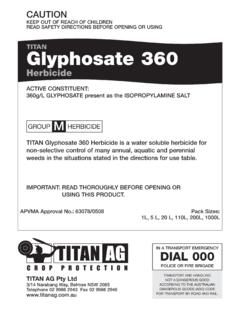Transcription of Development in Residential Zones - cumberland.nsw.gov.au
1 Part Development in Residential Zones Cumberland DCP Part B Development in Residential Zones This page has been left intentionally blank. Page B2 of B54. Cumberland DCP Part B Development in Residential Zones Part B Contents PART B1 DWELLING HOUSES AND SECONDARY DWELLINGS B6. 1. Introduction B8. 2. Objectives and Controls Setbacks B8. Height B9. Attics B10. Streetscape B11. Building Materials B12. Site Coverage B12. Landscaping B13. Private Open Space B14. Dwelling House Mix B15. Visual and Acoustic Privacy B16. Solar Access B18. Cross Ventilation B19. Ancillary Site Facilities B19. Fencing B20. Rainwater Tanks B21. Safety and Security B22. Cut and Fill B23. Car Parking and Site Access B23. Garages and Carports B24. Outbuildings B24. Secondary Dwellings B25. PART B2 LOW RISE MEDIUM DENSITY Development B29. 1. Introduction B31. 2. Relationship with Design guide B31. Relationships to Low Rise Housing Diversity Design guide for B31. Development Applications Page B3 of B54.
2 Cumberland DCP Part B Development in Residential Zones Development Control Standards to consider for B31. Low Rise Housing Diversity Development 3. Objectives and Controls Site Frontage B34. Overshadowing B34. Car Parking B35. Landscaping B35. PART B3 Residential FLAT BUILDINGS B37. 1. Introduction B39. 2. Relationship with SEPP 65 and Apartment Design guide B39. Relationship to SEPP65 / NSW Apartment Design guide B39. Development Control Standards to consider for Residential B39. Flat Buildings 3. Objectives and Controls Building Envelope B40. Basement Design B40. Site Layout B42. PART B4 BOARDING HOUSES B43. 1. Introduction B45. 2. Objectives and Controls General Objectives B45. Character and Amenity B45. Operational Management B46. Visual Privacy B47. General Design B48. Acoustics B48. Car Parking B49. PART B5 ADAPTABLE HOUSING AND HOUSING MIX B51. 1. Introduction B53. 2. Objectives and Controls Adaptable Housing B53. Page B4 of B54. Cumberland DCP Part B Development in Residential Zones Housing Mix B53.
3 This page has been left intentionally blank. Page B5 of B54. Cumberland DCP Part B Development in Residential Zones PART B1. DWELLING HOUSES AND. SECONDARY DWELLINGS. Page B6 of B54. Cumberland DCP Part B Development in Residential Zones This page has been left intentionally blank. Page B7 of B54. Cumberland DCP Part B Development in Residential Zones 1. Introduction Land to which this Part applies This Part applies to Development types detailed within this Part within land zoned Residential under Cumberland Local Environmental Plan 2021. Purpose of this Part This Part is intended to guide the assessment of the Development of a dwelling house, secondary dwelling and associated outbuildings. 2. Objectives and Controls Setbacks Objectives Ensure that the bulk and scale of new dwelling housing and alterations and additions to existing dwelling houses maintains the established bulk, scale and existing streetscape character. Provide sufficient separation between dwelling housing/buildings to allow for privacy, sunlight access and a sense of openness between buildings/dwelling housing.
4 Provide spatial separation between dwelling houses to minimise overshadowing of the proposed Development and manage potential privacy issues on surrounding residences and their private open space. Control Setbacks shall be provided in accordance with Table 1 and measured in accordance with Figure 1 and Figure 2. Table 1: Dwelling house setbacks Setbacks Front Setback (primary Minimum 6m frontage) Dwelling house shall align with the street Balconies, porticos, entrances may protrude by a maximum of Side Setback Minimum Side Setback (zero lot Maximum length of walls along the first floor side boundaries shall be 10m line) without any indentations or offsets or other articulation features. Indentations or offsets shall be a minimum width of 1m Rear Setback Minimum 8m Corner Dwelling House Minimum 2m (setbacks of less than 2m may be considered, subject to Setback justification and merit assessment). A corner dwelling house shall address both streets through appropriate design Where a new building is located on a corner, the main frontage shall be determined on the basis of existing subdivision and streetscape patterns Secondary Frontage Minimum 4m, with garage to be setback a minimum from property (setback where dwelling boundary faces secondary street).
5 Page B8 of B54. Cumberland DCP Part B Development in Residential Zones Figure 1: Front setback alignment Figure 2: Front setback alignment (curved street/cul-de-sac). Height Objectives Establish the maximum storey limit for single dwelling houses, their alterations and additions and associated outbuildings. Floor to ceiling heights provide well-proportioned rooms and spaces to allow for light and ventilation into the built form and ensures good internal amenity. Ensure sunlight access, privacy and amenity for new developments and neighbouring properties is maintained. Page B9 of B54. Cumberland DCP Part B Development in Residential Zones Controls A dwelling house and alterations and additions to a dwelling house shall be no more than 2 storeys in height. The minimum floor to ceiling height is Attics Objectives Allow attics where they do not impact on the bulk and scale of a dwelling house. Maintain sunlight access, privacy and amenity for the dwelling house and neighbouring properties.
6 Controls General Attics may be incorporated in a dwelling house where they comply with height and floorspace ratio requirements. The design of a dwelling house with attics is to minimise roof bulk. Roofs containing attics are not to exceed a 32 degree pitch. The external walls of the building should not extend above the attic floor level. Attics are to be no greater than 25m in floor area. Attics are to be designed to fit within the building envelope (with the exception of dormer windows) and are not to increase the bulk and height of the roof. Attic spaces shall have minimum wall height at the edge of the room with a 30. degree minimum ceiling slope. Two storey dwellings Attics within roof spaces of a 2 storey dwelling house may be used for storage purposes only and may not include any windows. One storey dwellings Habitable attics are only permitted in one storey dwellings. Habitable spaces within attics are to be designed with the ability to cross ventilate.
7 Dormer windows may be included in attics, provided they are no higher than the height of the main roof of the dwelling house, no greater than in width and are not to incorporate or access a balcony. Any proposed attic windows are not to overlook windows of adjacent dwellings or their private open spaces. An outlook to the street should be provided from attic windows where appropriate. Page B10 of B54. Cumberland DCP Part B Development in Residential Zones Figure 3: Attic diagram Streetscape Objectives Ensure that the appearance of Development is of high visual quality that enhances and addresses the street. Ensure that dwelling house design, detailing and finishes provide an appropriate scale to the street and add visual interest. Ensure that a dwelling house located on corner lots are designed to address both street frontages including windows and doors. Controls An articulation zone shall be permitted in the front setback to the primary street frontage.
8 The articulation zone is to be a maximum of in depth. Building elements permitted in the articulation zone include: verandahs, porticos/entry features, bay windows, awnings, shade structure, window box treatment, balcony, patio, pergola, terrace, verandah or steps. The dwelling house entry shall be visible from the street and provide a sense of address. Windows and doors in facades facing the street shall be provided in a balanced manner and respond to the orientation and internal uses. Large areas of blank, minimally or poorly articulated walls are not acceptable. Measures to avoid this may include windows, awnings, sun shading devices, pergolas, or a recognisable increased setback to the upper storey. Page B11 of B54. Cumberland DCP Part B Development in Residential Zones Building materials Objective Building design, detailing and finishes provide an appropriate scale to the street and add visual interest. Controls New dwelling houses and alterations and additions to existing dwelling houses shall use durable, quality materials that provide consistency and compatibility with the streetscape and character of its locality.
9 Building materials and/or colours shall be used to reduce the appearance of bulk. Building materials for dwelling houses and alterations and additions to existing dwelling houses must be compatible with the streetscape and character of its locality. Building materials and colours used for additions should integrate/blend with the original structure. Site coverage Objectives The site coverage must provide adequate areas for landscaping, including deep soil, infiltration of stormwater and private open space. Ensure that new dwelling housing and alterations and additions to existing dwelling housing are consistent with the character and the future amenity of its locality. Provide spatial separation between dwelling houses to minimise overshadowing of the proposed Development and manage potential privacy issues on surrounding residences and their private open space. Controls Site coverage shall be provided in accordance with Table 2 and Figure 4. The non-built upon area shall provide landscaping and deep soil opportunities as well as provide for private open space.
10 Table 2: Site coverage requirements Lot Size Maximum Site Coverage 450m2 or less 70%. 451m2 or greater 65%. Page B12 of B54. Cumberland DCP Part B Development in Residential Zones Figure 4: Site area diagram Landscaping Objectives Maintain and enhance the existing streetscape and landscaped character of the Residential neighbourhoods. Provide adequate opportunities for water infiltration and tall trees to grow and to spread, so as to create a canopy effect. Ensure that the landscaped area provided for a dwelling house has good solar access, optimises usability, privacy, accessibility, neighbours' amenity and provides a central uninhibited area for passive and active recreation. Controls The total landscaped area for a dwelling house shall be as follows: Table 3: Site coverage Lot Size Minimum Landscaped Area 450m2 or less 15%. 451m2 or greater 20%. Landscaped area includes areas edged orange in Figure 5. Page B13 of B54. Cumberland DCP Part B Development in Residential Zones Figure 5: Landscaped areas inclusion/exclusions The landscaped area shall be a deep soil zone.





